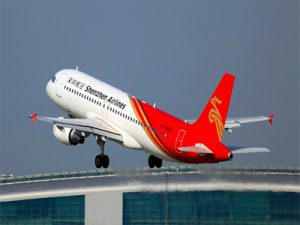
Shenzhen Airlines has selected Inmarsat’s next-generation SB-S satellite IP platform and Cobham’s cockpit connectivity solution to equip its entire Airbus A320 fleet enabling unprecedented visibility into operations through dedicated IP connectivity between the aircraft and the ground.
In addition, the airline has received a Supplemental Type Certificate (STC) to extend the system to its Boeing 737 aircraft. The Chinese operator has ordered 77 AVIATOR 300D systems for the Airbus aircraft and started a parallel evaluation of the system on the Boeing fleet.
The agreement follows a successful in-flight evaluation on the A320s during which the technology demonstrated significant communications, tracking and safety benefits and proved its compliance with the Civil Aviation Authority of China (CAAC)’s CCAR 121 and AC-121 (4-minute) mandates.
The Cobham AVIATOR 300D, powered by Inmarsat’s SB-S, provides a big data pipe to the cockpit while maintaining security through a data fortress door, which ensures physical segregation of different types of data and allows safe and speedy ACARS/FANS communications over IP and additional background IP capacity for airline operational use.
Inmarsat’s SB-S is the global secure broadband platform for operational and safety communications. It offers airlines unprecedented visibility into their operations through dedicated IP connectivity between the aircraft and the ground. SB-S can improve delay management and scheduling, maintenance capability, fleet and flight crew management, efficiency and predictability, and reduces turnaround time of aircraft. Air traffic management and control is facilitated through reduced separation standards, user preferred routes with dynamic rerouting and tailored arrivals. The system will enable Shenzhen Airlines to fly FANS routes and ensures compliance with the CAAC mandate requiring airlines to operate and control voice communications independent of Air Traffic Control within four minutes.
The advanced SB-S aviation safety service is available to Chinese airlines under an agreement between Inmarsat, China Transport Telecommunication Information Group Company Limited (CTTIC) and Aviation Data Communication Corporation (ADCC) that leverages the unique capabilities of CTTIC’s Beijing satellite access station, ADCC’s experience in providing flight datalink services in China and Inmarsat’s proven expertise in providing market-leading satellite communications services to the aviation industry.
Speaking about the agreement, John Broughton, Vice President of Safety and Operational Services at Inmarsat Aviation, said: “We are delighted that our next generation SB-S platform is being rolled out by Shenzhen Airlines in China, one of the fastest growing aviation markets in the world and a key focus area for Inmarsat. The innovative airline has already evaluated SB-S over the last year using the Cobham AVIATOR 300D system, so they have experienced first-hand its ability to transform visibility of aircraft operations. We look forward to working with them and our partners further on this A320 fleet rollout and parallel Boeing fleet evaluation.”
Cheng-Yu Tang, General Manager, Cobham SATCOM Greater China, who was in charge of this project, added: “With this new order, Shenzhen has demonstrated its confidence in our AVIATOR 300D system and the Inmarsat SB-S IP platform through CTTIC’s turn-key solutions and its Aero Safety Data Platform, and also proved it is fully committed to optimising flight deck and aircraft operations across their fleets in this ground-breaking new era in Chinese aviation. We are excited to work with Shenzhen and other airlines as we continue to develop communication technologies to meet the future needs of the aviation community.”












Add Comment